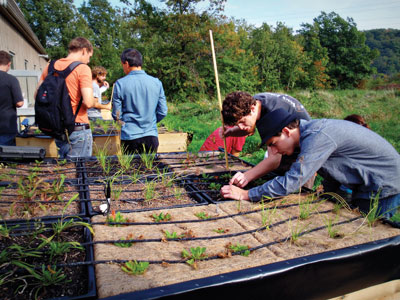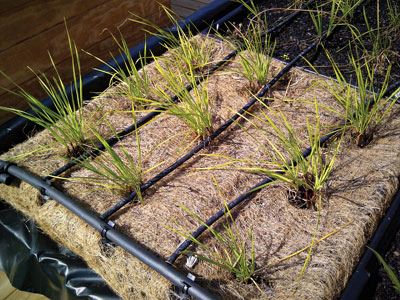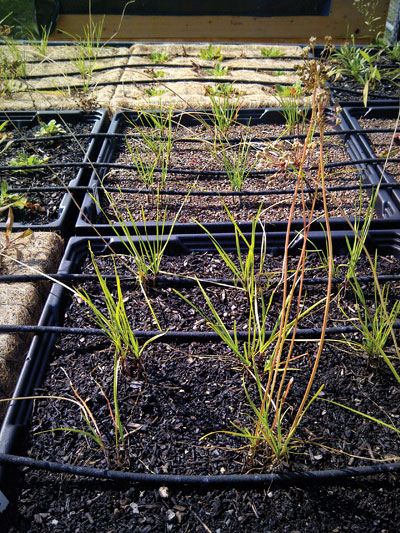
Features
Business
Grower Profiles
Lofty goals for Niagara
March 20, 2012 By Jesse Hollanda and Jason Wrixon
A major 2002 workshop concluded that, despite the many benefits of green
roofs in insulating and protecting buildings from the elements
A major 2002 workshop concluded that, despite the many benefits of green roofs in insulating and protecting buildings from the elements as well as reducing sewage overflow, a major barrier obstructing the green roof market in Canada was the lack of climate-specific performance data and demonstrated feasibility (Connelly & Liu, 2005).
 |
|
| Students Brice Danbrook and Adam Merkel take measurements. PHOTOS BY KATIE JOB, GREENHOUSE TECHNICIAN PROGRAM STUDENT Advertisement
|
There are currently three major facilities devoted to green roof research in Canada: The British Columbia Institute of Technology (BCIT) Green Roof Research Facility in Vancouver.
The Field Roofing Facility operated by the National Research Council of Canada in Ottawa.
Niagara College of Applied Arts and Technology in Niagara-on-the-Lake, Ontario.
In 2010, the Vineland Research and Innovation Centre, located in Vineland, Ont., finished construction of a large green roof for research purposes as well.
All this work is designed to provide the necessary data to support a more widespread use of green roofs in Canada.
STUDENTS, FACULTY AND INDUSTRY TEAM UP IN RESEARCH PROJECTS
Niagara College responded to this need for focused research by incorporating green roof studies directly into its Horticulture, Greenhouse, and Landscape Technician programs.
After attending “Green Roof Boot Camp” in 2008, horticulture instructors Mike Hoekstra and Olga Piedrahita returned with the knowledge that green roof experience was necessary to help students become future industry leaders. With this in mind, the college’s research team began tackling the key issues preventing wide-scale marketability of green roofs in Canada.
This included research that tested the survivability of native plant material rather than the non-native sedum species currently used. Native plantings complement the existing ecosystem rather than compete with it, while providing a suitable habitat for local fauna, thereby enhancing the natural biodiversity of the region. Further to this, new Canadian legislation prohibits the planting of non-native species on prized natural landmarks such as the Niagara Escarpment.
Further research tested the more commonly used nursery style drip-ring style of irrigation system, in which water is delivered when placed in the centre of the container, against a newer line system where the same drip cord is placed lengthwise through the plants at evenly spaced intervals (2009).
EVALUATING NEW, LIGHTWEIGHT GROWING MEDIA FOR GREEN ROOFS
As well, new lightweight growing media with increased organic content is being evaluated as a potential replacement for the heavy pumice and gravel-based substrates in traditional green roof applications.
 |
|
| Individual module used in media evaluation.
|
Studies such as these illustrate the opportunities for students and industry alike to address the barriers that stand in the way of expanding the green roof market.
In 2011, the college further expanded its research capabilities with the construction of eight new green roofs. With the help of Bill Macdonald, professor of Plant Sciences, and Mike Hoekstra, coordinator of the Landscape Technician program, the new green roofs were designed, built and installed by students in the program. Building these roofs was no easy feat, and the task provided hands-on experience for those students to take into the workforce.
The horticulture industry has already demonstrated its desire to get involved, with companies such as Dramm Corporation, GreenGrid Roofs and Gro-Bark Custom Soilless Mixes participating in current projects.
NATIVE PLANT MATERIAL CENTRE OF ATTENTION
All of the native plant material being studied was grown locally at the St. Williams Nursery and Ecological Centre.
 |
|
| Native plants.
|
In addition, St. Williams is providing a unique ultra-lightweight growing media composed of recycled styrofoam for the college’s current project. Developed by The Gaia Institute in Bronx, N.Y., a cubic foot of Gaia Soil™ has about one-third the weight of standard green roof growing media when saturated with water (Dalski, 2008).
The college is moving toward developing courses with a specific focus on living architecture applications, such as green roof technology. It is easy to see how students are being groomed to be leaders in a rapidly expanding new industry.
This is well summed up by one student researcher: “I am excited that green roofs are becoming more popular, and my experience at Niagara Research provides me with a solid background to share this knowledge with future generations.”
The success of the research conducted at Niagara College can be seen in the practical value it holds for the field. Industry partner Dramm now markets an irrigation system trialled by Niagara College researchers in both Canada and the U.S. The research proved the effectiveness of this technology. It was a collaborative effort by industry and students – a win-win arrangement, to be sure.
CLOSE COLLABORATION WITH INDUSTRY PARTNERS
“Industry partners get students to work with their products and put them to the test,” explains Tanya Blankenburg, a professor and researcher at the college. “The results can assist with future research projects and direct how industry will market products.”
Research coordinator Olga Piedrahita says the decision to implement green roof research was based on “the responsibility (of the college) to give students experience in areas that are new and innovative in the industry. We have many partners in this program reflecting the industry’s interests.”
For recent alumnus and first-generation green roof researcher Joanna VanLuttikhizen, this experience yields benefits each day at work as a biological systems specialist with Koppert Canada.
“The biggest benefit for me was learning how to work independently,” notes VanLuttikhizen. “You have to think on your feet and solve problems quickly.”
The practical benefit for students working on these projects is undeniable.
Green roof research at Niagara College has undergone a three-year metamorphosis, starting with just a few dedicated researchers and evolving into a full-blown learning experience for those up for the challenge.
“As someone going into greenhouse industry,” says researcher Arde Eghbali, “I will benefit from knowing which species are suitable for a green roof installation and if they can be grown in a greenhouse.”
PROGRAM GREW LAST YEAR, WITH PLANS TO EXPAND AGAIN
Piedrahita has high hopes for the future of this research.
“We have expanded our research area in 2011 and hope to do so again in 2012. We hope to expand our on-site weather station to obtain more detailed data. We will be expanding our projects and our industry partners.”
Niagara College students and faculty, in collaboration with industry partners, are continuing to make progress towards the goal of making green roofs more practical through applied research and learning dedicated to creating a more sustainable world.
To learn more, visit www.niagaracollege.ca/research or stop by the college’s green roofs and see what the students are up to.
“Innovation distinguishes between a leader and a follower.” – Steve Jobs, 2006
REFERENCES
Connelly, M., & Liu, K. (2005, May 5). Green Roof Research in British Columbia – An Overview. Retrieved November 6, 2011, from National Research Council of Canada (NRCC): http://www.nrc-cnrc.gc.ca
Dalski, E. (2008, August 4). GaiaSoil – The Gaia Institute. Bronx, New York, U.S.
Jesse Hollanda (Horticulture Technician program) and Jason Wrixon (Greenhouse Technician program) are students at Niagara College.
Print this page